Okra, also known as lady’s finger, is a popular vegetable native to Africa. It belongs to the mallow family (Malvaceae) and is related to hibiscus, cotton, and cocoa plants. The green edible seed pods of okra are widely consumed worldwide, such as boiled, fried, steamed, and roasted.
Okra is a highly nutritious vegetable, rich in essential vitamins, minerals, and antioxidants. It contains dietary fiber, which helps to improve digestion and prevent constipation. Here is everything you need to know about okra’s health benefits, nutrition facts, and culinary uses.
History and Origin of Okra:
Okra is believed to have originated in the tropical regions of Africa, where it has been cultivated for centuries. From there, it was brought to India, China, and other parts of Asia before spreading to Europe and, eventually, the Americas. Okra is now grown around the world in both warm and temperate climates.
Types of Okra:
Okra comes in a variety of shapes, sizes, and colors. The most commonly available types are green, red, and yellow okra. When cooked, all varieties have a distinctively slimy texture, which is why it is sometimes referred to as “gumbo” or “lady’s finger.”
Health Benefits of Okra:
- Good Source of Vitamins and Minerals: Okra is a very good source of essential vitamins such as vitamins A, C, and K. It also contains minerals such as potassium, calcium, iron, magnesium, and zinc. These vitamins and minerals are essential for the proper functioning of the body.
- Lowers Cholesterol: Okra contains high amounts of dietary fiber, which helps to reduce bad cholesterol in the blood. This can help lower the risk of heart disease and stroke.
- Prevents Cancer: Okra is an excellent source of antioxidants such as anthocyanins and polyphenols. These compounds help to protect the body against cancer-causing free radicals.
- Improves Digestion: Okra is rich in dietary fiber, which helps to improve digestion and prevent constipation. It also helps to reduce bloating and discomfort caused by indigestion.
Nutrition Facts about Okra:
Okra is an excellent source of essential vitamins and minerals. It contains:
-Vitamin A (14% of the RDI) -Vitamin C (15% of the RDI) -Vitamin K (32% of the RDI) -Potassium (9% of the RDI) -Calcium (6% of the RDI) -Iron (7% of the RDI) -Magnesium (8% of the RDI)
Culinary Uses of Okra:
Okra is a versatile vegetable that can be used in many different dishes. It can be boiled, steamed, fried, roasted, or added to stews and soups. It also makes an excellent addition to curries, stir-fries, and salads. Pickled okra has a tangy flavor and can be enjoyed as an appetizer or snack. Additionally, okra leaves can be eaten as leafy greens or added to salads for extra flavor and nutrition.
Interesting Facts About Okra:
Here are some interesting facts about this amazing vegetable:
- Okra is believed to have originated in Ethiopia and was brought to the Americas by enslaved Africans.
- Okra plants can grow up to 8 feet tall with large leaves.
- The okra plant produces yellow flowers that produce edible pods which contain seeds.
- In the United States, okra is most commonly grown in states like Alabama, Florida, Georgia, and Mississippi.
- Okra is a rich source of vitamins A and C, iron, calcium, dietary fiber, and antioxidants that help reduce inflammation and protect against disease.
- Okra has been used for centuries to treat various health conditions, including digestive issues, constipation, diabetes, and asthma.
Okra is a nutritious and versatile vegetable that can be enjoyed in many different dishes. It is an excellent source of essential vitamins, minerals, and antioxidants, which are important for our overall health. Eating okra regularly may help lower cholesterol levels, improve digestion and reduce cancer risk. We hope this article has helped to give you information about okra’s health benefits, nutrition facts, and culinary uses.
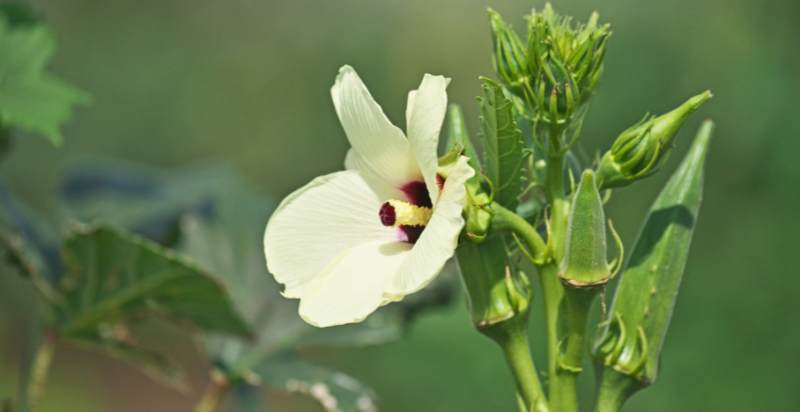
How to Plant Okra?
Okra is a popular vegetable that can be grown in almost any climate. It has a unique flavor and texture packed with vital vitamins and minerals. Growing okra can be done easily by following some simple steps. This section will discuss how to plant okra, what kind of soil it prefers when to water it, and other tips for successful growth.
Choosing the Right Soil:
The key to healthy okra plants lies in choosing the right soil type. Okra prefers well-draining soils rich in organic matter like compost or manure. Sandy loam soils with a pH between 5.5 – 7.0 are ideal for growing okra successfully. The soil should also be well aerated; okra needs air to thrive.
Planting Okra:
Okra seeds should be planted 1/2 inch deep in the soil. Space the seeds 6-8 inches apart and water them regularly. It’s important to keep the soil moist during germination and the early stages of growth for optimal results. Once your okra plants are established, water them deeply once a week or when you notice that the top 2 inches of soil are dry.
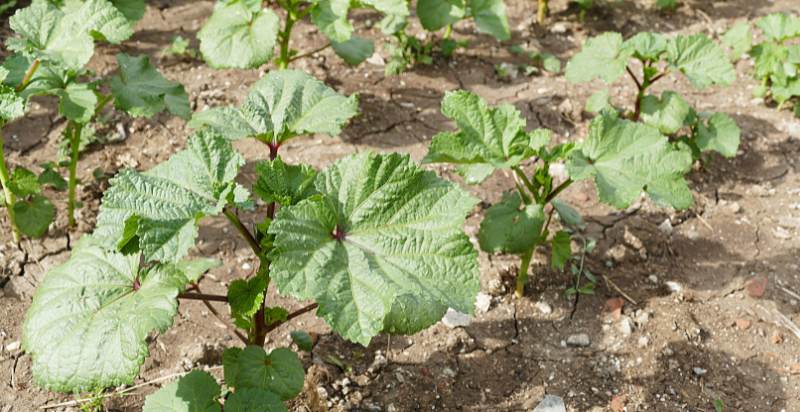
Fertilizing:
Okra benefits from regular fertilization throughout its lifecycle. You can use organic compost or manure to provide vital nutrients for healthy growth and development. A balanced fertilizer such as 10-10-10 or 20-20-20 can also be used. Be sure to follow the instructions on the package carefully when applying fertilizer.
Mulching:
Mulch is essential for keeping weeds at bay and maintaining soil moisture during hot summer. Spread a 2-3 inch layer of mulch around your okra plants to help retain moisture in the soil. This will also keep weeds from competing with your okra for water and nutrients.
Harvesting Okra:
Okra should begin producing flowers and pods within 2 months after planting. The best time to harvest okra is when the pods are young, tender, and 3-4 inches long. If allowed to mature too long, they will become woody and inedible. Harvest your okra pods frequently to keep the plant producing.
Growing okra is fairly simple. It only requires a few basic steps, such as choosing the right soil, planting seeds properly, fertilizing regularly, mulching to help retain moisture, and harvesting on time. These tips should help ensure you have healthy and productive okra plants for many seasons.
How to Care for Okra?
Caring for okra is fairly simple and doesn’t require much effort. After planting, water your okra regularly until the soil has been soaked to a depth of 2 inches. This helps to ensure that the roots have access to plenty of moisture.
Fertilize your plants once every few weeks with a balanced fertilizer such as 10-10-10 or 20-20-20. Mulch around the base of the plant to help retain moisture and keep weeds at bay. Lastly, harvest your okra pods when they are young and tender, usually 3-4 inches long.
Following these steps should lead you to a successful okra crop each season.
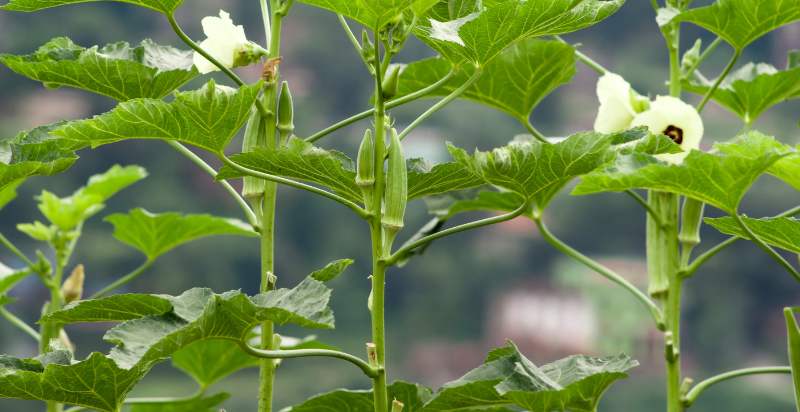
Preventions From Pests and Diseases:
Okra is susceptible to several diseases and pests. To prevent them, be sure to plant your okra in well-draining soil that is rich in organic matter. Mulch around the base of the plants to help retain moisture levels and deter weeds. Rotate your crops each season to help avoid pests and diseases that may linger in the soil from year to year. Finally, keep an eye out for signs of disease, such as yellowing foliage or discolored stems, and treat accordingly with fungicide or insecticide if necessary.
By following these simple steps, you should be able to enjoy a healthy crop of okra without worrying about pests or diseases.
How to Harvest Okra?
Okra is ready to harvest when the pods are 3-4 inches long and tender. They will become woody and inedible if left on the vine too long. Harvest okra early in the morning or late in the evening before temperatures rise, which helps prevent wilting. Use a sharp knife or secateurs and cut the pods off at the stem, leaving an inch of stem attached to ensure that plenty of nutrients are sent back into the plant for continued production.
If you’re harvesting more than you can use right away, okra can be stored in an airtight container in the refrigerator for up to 1 week. Alternatively, it can also be frozen for up to 6 months.
Harvesting okra at the right time is essential for a successful crop. Be sure to pick your okra when the pods are young, tender, and 3-4 inches long for best results.
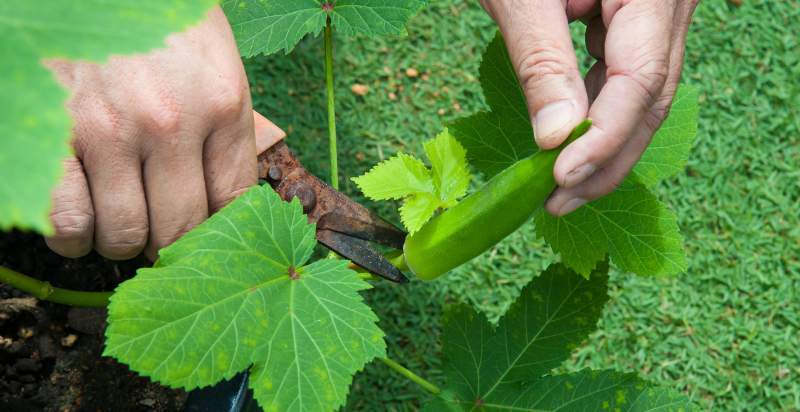
How to Store Homegrown Okra?
Homegrown okra can be stored in an airtight container in the refrigerator for up to 1 week. Alternatively, you can also freeze it for up to 6 months. To freeze, blanch the pods first by dropping them into boiling water for 1 minute and then immediately transferring them to a bowl of ice water.
Once cooled, drain off any excess liquid and place the pods on a baking sheet or tray lined with parchment paper. Freeze until solid before transferring them to an airtight container or freezer bag. When ready to use, thaw at room temperature or in the refrigerator overnight before cooking as usual.
Following these simple steps, you should have plenty of homegrown okra all season long.
How to Use Okra?
Okra is a delicious and nutritious vegetable that can be prepared in many different ways. Here are some easy steps to prepare it:
- Wash the okra thoroughly with cold water to remove dirt and debris.
- Slice the okra into 1/4 inch pieces, or cut it lengthwise for longer pods.
- Heat oil in a skillet and add the sliced okra. Fry until lightly browned, about 5 minutes.
- Add seasoning, such as salt, pepper, and garlic powder, to taste.
- Serve with your favorite dishes, or enjoy them as a healthy snack!
Bonus Aside: Alternative Uses for Okra
Okra can also be used in other ways beyond the kitchen. Here are some creative uses for okra:
- Natural Cleaning Agent – Slice okra and combine it with a few drops of lemon juice to create a natural cleaning agent that is great for cleaning glass and mirrors.
- Hair Treatment – Mash up cooked okra and add it to your shampoo or conditioner for a nourishing hair treatment that helps to strengthen, smooth, and moisturize your hair.
- Skin Care – Create an okra face mask by mashing cooked okra into a paste, then applying it to your skin as you would any other facial mask. The natural enzymes and fatty acids in okra can help to reduce inflammation, hydrate skin, and protect against free radicals.
- Garden Pest Control – Relieve your garden of pesky bugs by creating an okra spray. Blend okra pieces with water, strain the mixture, and pour into a spray bottle. Use this solution to eliminate bugs from your garden without harsh chemicals.
Bonus Aside 2: Okra Recipes
Now that you know about okra’s health benefits and nutritional content, why not try out some easy recipes to enjoy this delicious vegetable? Here are a few ideas for tasty appetizers, snacks, and main dishes featuring okra:
- Roasted Okra – Preheat the oven to 400°F. Toss sliced okra with olive oil, salt, pepper, and your favorite spices. Spread the okra on a baking sheet lined with parchment paper in an even layer. Bake for 25 minutes or until golden brown.
- Stuffed Okra – Slice fresh okra lengthwise and scoop out centers using a spoon or melon baller. Stuff with your favorite savory filling, such as cheese, herbs, or cooked mushrooms. Bake at 375°F for 15-20 minutes or until okra is lightly browned and the filling is hot.
- Fried Okra – Heat oil in a skillet over medium heat. Toss sliced okra with cornmeal and seasonings of your choice. Fry in batches until golden brown and crisp, about 5 minutes per batch. Serve with a side of ranch dressing or hot sauce for dipping.
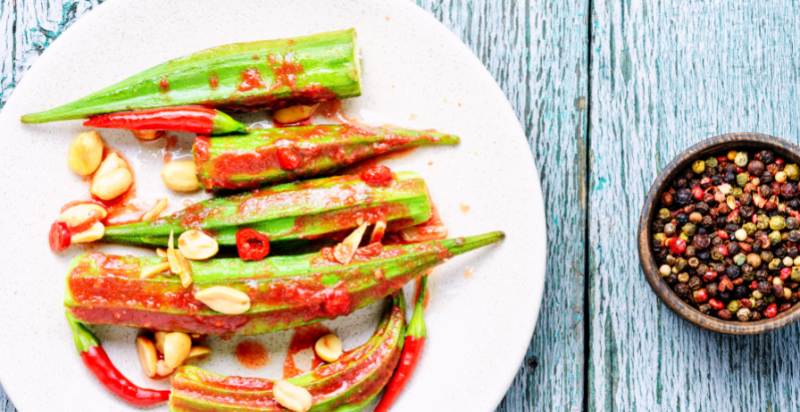
Potential Risks from Okra:
Although okra is generally safe to eat, it can cause potential side effects. Eating high amounts of okra may lead to digestive upset such as bloating, gas, and stomach discomfort. Additionally, the slimy texture of cooked okra may not be suitable for those with certain digestive issues.
Allergic reactions are also possible with okra, so it’s important to watch out for any signs of an allergic reaction if you try it. Finally, caution should be taken when eating large quantities of raw okra, as this could lead to choking or other serious health risks.
By paying attention to the potential risks associated with okra, you can enjoy this unique vegetable safely and deliciously.
Conclusion:
Okra is a nutritious and flavorful vegetable that can be enjoyed in many dishes. Knowing how to grow, harvest, store, and use okra is essential for ensuring a successful crop. Additionally, it’s important to be aware of the potential risks of consuming large quantities of this unique vegetable. With these simple tips in mind, you can enjoy fresh homegrown okra all season long.
Want to learn about Chinese okra? Dive into our article to gain insights on growing, harvesting and caring the plant.
- Everything You Wanted to Know About Red Tamarillos - June 2, 2025
- A Guide to Tulips: Everything You Need to Know & More… - June 2, 2025
- Guanabana: Description, Flavor, Benefits, And Uses - May 27, 2025

2 thoughts on “What is Okra? How to Plant, Grow, and Harvest Okra. ”
Comments are closed.